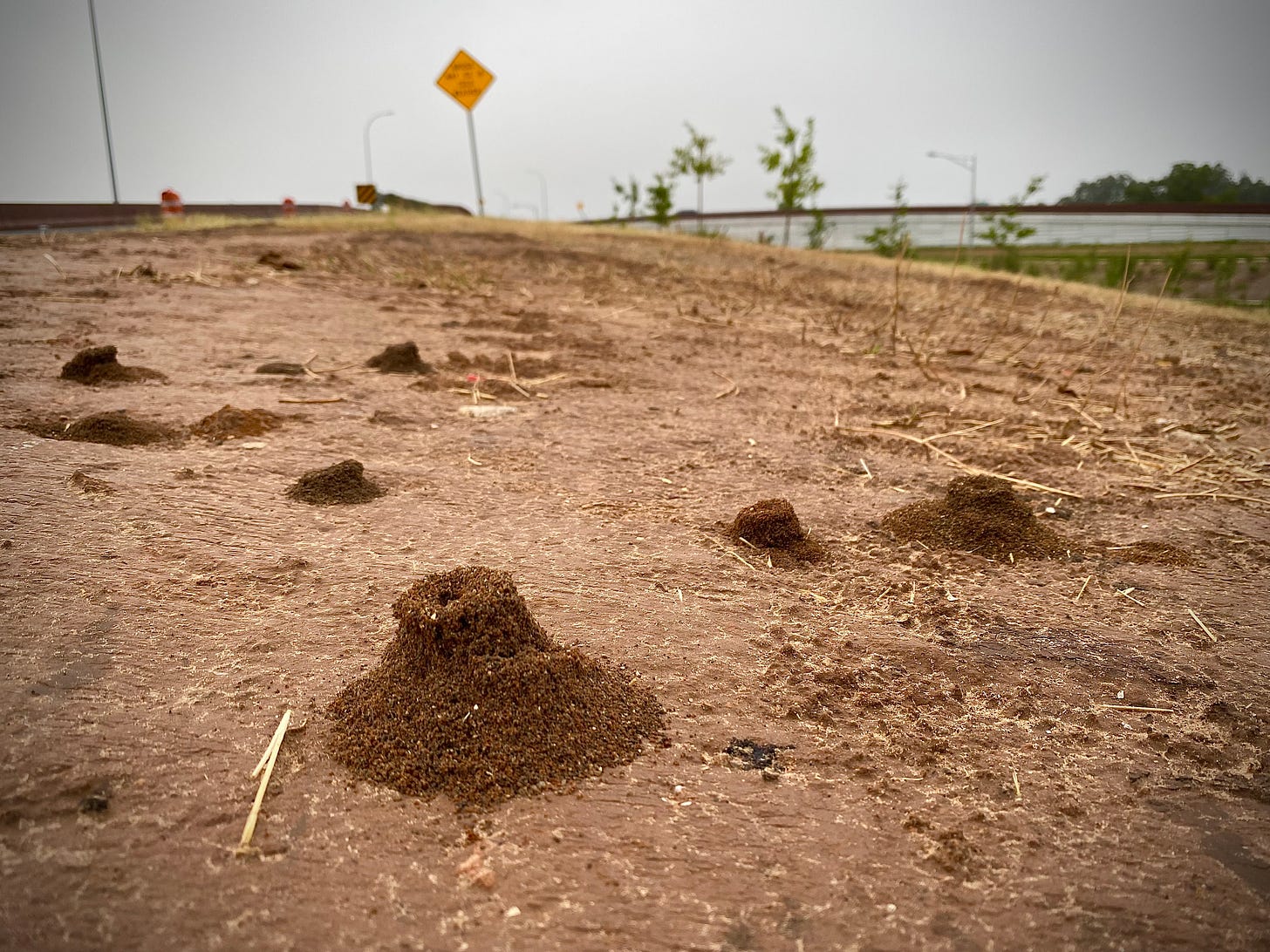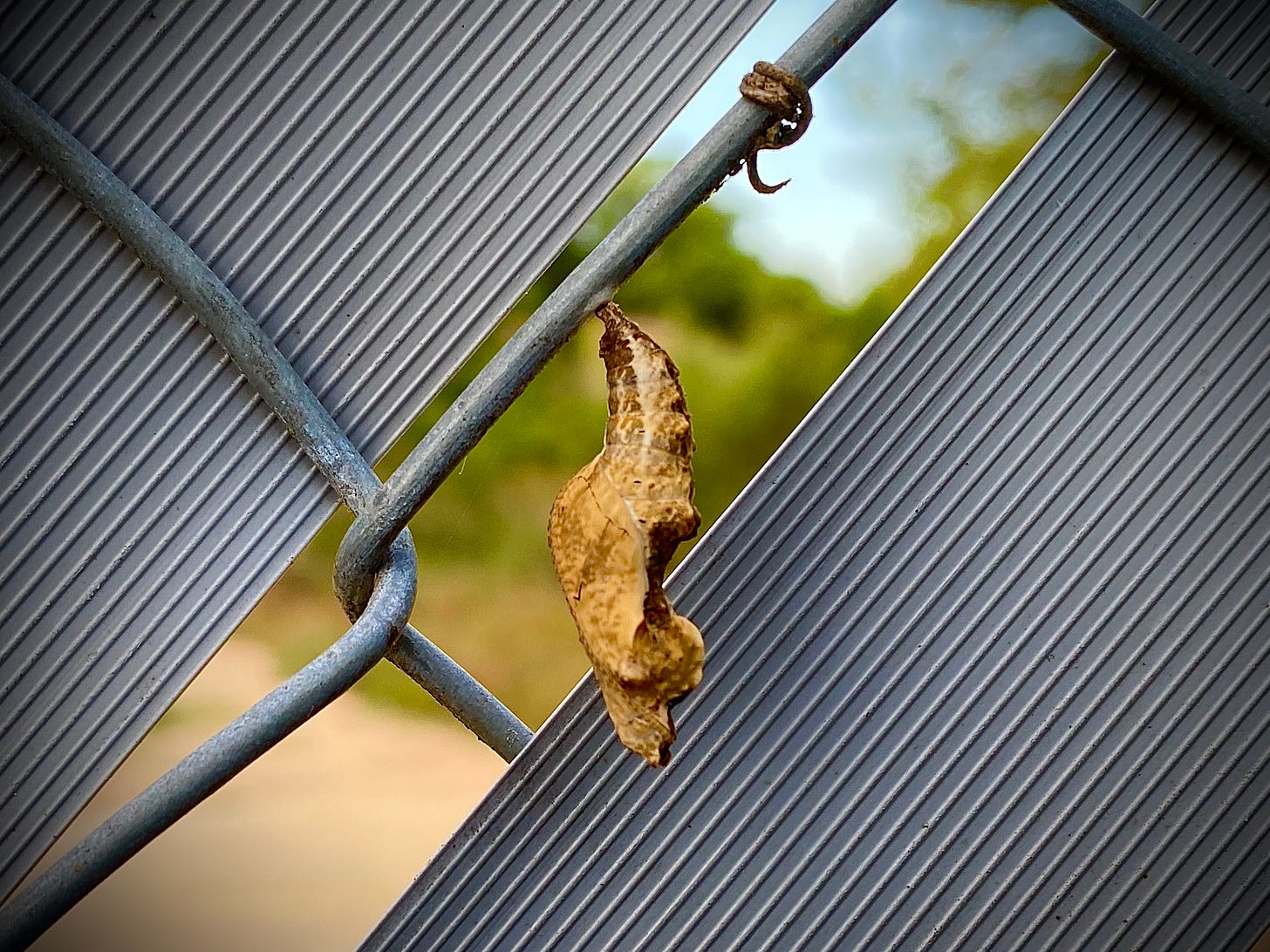Michaelmas Lineman
The day after Michaelmas I spotted a red-tailed hawk perched on the telephone pole that marks the spot where the abandoned ferry road runs into the woods behind the factories. A sign of the change in seasons, perhaps, as redtails are much less common to see around here than they are in more northern climes, often along interstate highways. These edgeland woods along the Lower Colorado are dominated by red-shouldered hawks. It took me longer than it should have to learn to tell the difference between the two species, especially since they both flash some red. Now I can tell even without the aid of binoculars or a long lens camera, even when the profile is no clearer than in the phone pic above. The redtail looks like it’s wearing grey flannel with a white shirt, whereas its red-shouldered cousin breaks out the rusty autumnal tweeds. Lawyer versus law professor.
The ferry hasn’t operated for a hundred years, and the road has been closed for half as long, but its right of way is still used by wild animals and Internet service providers. At night the foxes who den behind the door factory use it as a corridor to the concrete jungle, sneaking out under the chain link to hunt rodents behind restaurants. In daylight the network technicians come out every so often to hang new cable to add more bandwidth. Google was the last one I saw with its crews up there in the cherry pickers on a hot summer day, reminding you that the network the software salesmen magically describe as the Cloud has a less ethereal physical embodiment in nature, much of it running along more ancient pathways we stole from the Indians, and they got from the migratory megafauna we mostly exterminated.
The day before Michaelmas I noticed that the old AT&T maintenance yard around the corner looks to have been finally abandoned for good by its longtime corporate owner. It’s looked half-abandoned before, only to repopulate with those white vans marked with that image of the Earth bathed in data. But this time it had the telltale signs of a move out—full dumpsters and the tracks of old boxes and files and tools that might still prove useful, or at least of some asset value to the comptrollers. The field where the technicians learned to climb the telephone poles remains. It’s too bad it won’t last long enough to mature into the enigmatic henge it wants to be, a primitive geometric array of tall pines stripped of their natural features, painted with tar, and transplanted into an escalating formation that reaches for the morning sun and the jetliners writing lines across the sky.
Chances are that lot got bought by the same developer who recently scored the old truck yard that surrounds it, and in a few years will be transformed into a glamorous new mixed-use project designed to make real life feel and function more like Instagram. For now those empty industrial yards serve as temporary backlots of cyberspace. On Thursday the truck depot was again serving as a training pen for the new Amazon drivers, learning how to follow the instructions of supply chain algorithms. On Friday both lots had been taken over by a big film crew working to fill the backorders for fresh streaming entertainment. Whether it was melancholy Texas Rangers or the zombies next door, I couldn’t tell.
When the AT&T vans still rolled in and out of that yard, often as we were walking by, I sometimes imagined what miserable jobs those must be, working for a company that combines the worst qualities of business corporation and government agency—the conglomerate that owns the dial-tone, listens to your calls, and managed to reassemble itself even bigger within a couple decades of its forced breakup. Imagine the layers of bureaucratic controls it must impose to translate the dictates of the corporate personality down to the field technicians, profit and productivity maximization bound up with risk management and the field vocabulary of photonic engineers.
On Michaelmas I wondered whether any of those technicians, freed from their daily grind, from the kind of job where a bot texts the customer for a review the minute you leave and if the response is less than perfect you will soon be sitting in one of those sheds for your Friday afternoon supervisory interrogation, might go rogue, like DeNiro’s revolutionary HVAC repairman in Brazil. Might they have the secret power to connect us to the version of the Internet that doesn’t suck? The one we thought we were about to get when it all seemed like liberated territory, an Internet without commerce or advertising, instead of the one we got that is nothing but. Maybe that’s why walking in the woods along paths marked to show where the Internet is buried is such a strangely rewarding exercise.
Corporate heraldry and mad Mad Men
Turns out the original design for AT&T’s “Death Star” logo was created by the famed film titles maestro Saul Bass in 1983, as the original parent company was forced to abandon its century-old Bell logo in connection with the court-ordered breakup into regional operating companies. Deeper digging reveals that Bass also did the big redesign in 1969 that marked the pop art-inflected reinvention of the original Bell. You can find a full history here at Logopedia, a site entirely devoted to corporate logo fandom (and proof that the Internet doesn’t completely suck).
If you want to stream something fresh, you can watch all 27 mind-blowing minutes of the video pitch Bass made to persuade AT&T’s execs to make the change. It’s an unexpected manifesto of liberation, for the company and its customers, urging them to get in on the Age of Aquarius before it’s too late. Watching it, you can almost imagine an alternate path where the commercial Internet got built out with this ethos as its backbone.
I thought of Saul Bass Thursday morning as I traversed the new onramp that leads to the bridge that replaced the old ferry. Along the pavement there were two new mounds of harvester ants, who, as noted here before, regulate the number of foragers they dispatch based on the quantity of grain being brought back by those previously dispatched, in a manner algorithmically identical to TCP/IP, the protocol that enables data to be transmitted in packets and the distributed network potential of the Internet.
Nearby were the Lilliputian towers of a smaller species of ant, which reminded me of Bass’s one feature film, Phase IV, a trippy 1974 cozy catastrophe about cosmically touched ants who take over the Earth and make us their happy and willing slaves. I watched the film for the first time last year, part of my eco-horror binge. Now I wonder if maybe it was more prescient than it seemed. As the ants colonize those data rights of way, how long before they merge with the net and the human hive mind? Maybe they already have.
Festival season
Down the hill from those anthills, here at what used to be just outside the Austin city limits, I came upon some remarkable new street art murals Thursday on one of the abandoned warehouses next to the traffic island I explored last week. This one of a girl being carried by her grandma across the Rio Bravo was especially amazing. It’s always wonderful to see these sorts of ephemeral works before they are marred by taggers or redevelopers.
I had never heard of Michaelmas until the year I spent at Oxford as a junior in college. It was what they named the autumn trimester, and I eventually learned to correctly pronounce it, without learning what its real derivation was. In England it’s a Christian festival day consecrated to the archangels, apparently rooted in the more ancient Celtic harvest festival Lughnasadh. I wonder if the creators of the Austin City Limits music festival had that in mind when they picked September’s end as their annual date. Maybe ACL is a climate crisis variation on the equinox fest, celebrating the annual break from months of heat so intense and oppressive it prevents us from going outside for any activity that doesn’t involve getting in the water.
(Don’t tell Alex Jones—after the default judgment one of our local judges awarded the Sandy Hook parents against him this week, there’s a good chance he’ll show up at the festival gates with his megaphone screaming about pagan devil worship and Greta Van Fleet (there was no sign of him yesterday, at ACL or the Women's March). )
I had fun at that festival in its early years, when smartphones were not yet ubiquitous, and even if you had one, the network was always overloaded and the way you found your friends was more medieval, looking for their banners across the wide field. But I still prefer the original public TV show, and was pleased to find this 1985 Austin City Limits performance by Glen Campbell of “Wichita Lineman,” the eerie Jimmy Webb song he made a hit. I never got why my dad loved Glen Campbell so much when I was a kid, but I later came to appreciate the dial-tone age melancholy of this tune:
On Saturday morning as we returned from the playground, we noticed that tall single-stemmed white wildflowers had erupted from all the mowed patches of grass in the medians and along the sidewalks. Some kind of wild onion, perhaps, and later we saw them all over town. When we got home, we found a fresh fritillary cocoon on our front gate, where the volunteer passion vine is finally starting to brown out.
There are a lot more butterflies this year than last, and our daughter is just at the age where she starts to take more notice of them. Hopefully they will be back again next year. For now, her main activity by the butterfly bushes is to pick a single pea-sized chili piquin every time we walk by and make me bite down on all 60,000 scovilles. Friday she fed me one that was beginning to dry on the vine, making it extra potent. I wonder what evolutionary coding it is that has her already know it’s the red ones that are ripe.
I suppose there’s a Matrix riff embedded in there, but time will tell how well we are able to use wild nature to counterbalance our daughter’s experience of a life mediated by screens.
Have a great week, and if you have time to go for a walk, consider following the nearest wired right of way to see where it takes you. You might be surprised.













Wow. Another stunning trek, Chris. I was ready for surprises, but still, I did not expect Saul Bass. The sting of that pepper was appropriately placed near the end, for yet another of many unexpected side trips. It's early and my vocabulary is a bit sluggish, so I'm struggling here, but really, you're a helluva writer and thinker.
Another wonderful, thought-provoking post. Saul Bass was especially interesting. How do you come up with such fascinating subjects each week?